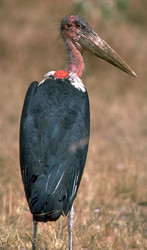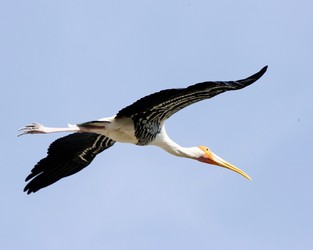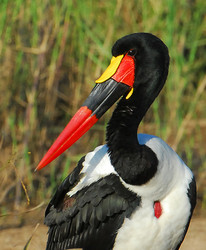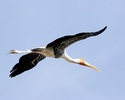Ciconiiformes
Ciconiidae
Storks
John Harshman

This tree diagram shows the relationships between several groups of organisms.
The root of the current tree connects the organisms featured in this tree to their containing group and the rest of the Tree of Life. The basal branching point in the tree represents the ancestor of the other groups in the tree. This ancestor diversified over time into several descendent subgroups, which are represented as internal nodes and terminal taxa to the right.

You can click on the root to travel down the Tree of Life all the way to the root of all Life, and you can click on the names of descendent subgroups to travel up the Tree of Life all the way to individual species.
For more information on ToL tree formatting, please see Interpreting the Tree or Classification. To learn more about phylogenetic trees, please visit our Phylogenetic Biology pages.
close boxRelationships after Slikas 1997.
Discussion of Phylogenetic Relationships
Ciconiiformes has traditionally included several families in addition to Ciconiidae: Threskornithidae (ibises), Ardeidae (herons), Balaeniceps (shoebill), and Scopus (hamerkop), all of which are actually closer to Pelecanidae than to Ciconiidae, and therefore have been placed in Pelecaniformes. Another family, Phoenicopteridae (flamingos) is also sometimes included in Ciconiiformes, but is not within "Water Birds". Thus the only family actually in the order Ciconiiformes is Ciconiidae itself (Hackett et al. 2008).
References
Hackett, S. J., Kimball, R. T., Reddy, S., Bowie, R. C. K., Braun, E. L., Braun, M. J., Chojnowski, J. L., Cox, W. A., Han, K.-L., Harshman, J., Huddleston, C. J., Marks, B. D., Miglia, K. J., Moore, W. A., Sheldon, F. H., Steadman, D. W., Witt, C. C., and Yuri, T. 2008. A phylogenomic study of birds reveals their evolutionary history. Science 320(5884):1763-1768.
Sheldon, F. H. and B. Slikas. 1997. Advances in Ciconiiform Systematics. Colonial Waterbirds 20(1):106-114.
Slikas, B. 1997. Phylogeny of the avian family Ciconiidae (storks) based on cytochrome b sequences and DNA-DNA hybridization distances. Molecular Phylogenetics and Evolution 8: 275-300.
Slikas, B. 1998. Recognizing and testing homology of courtship displays in storks (Aves : Ciconiiformes : Ciconiidae). Evolution 52(3):884-893.
Soothill, E. and R. Soothill. 1989. Wading Birds of the World. 2nd ed. London: Blandford.
Title Illustrations

| Scientific Name | Leptoptilos crumeniferus |
|---|---|
| Location | Southern Serengeti |
| Comments | Marabou Stork |
| Specimen Condition | Live Specimen |
| Copyright |
© Greg and Marybeth Dimijian

|
| Scientific Name | Mycteria leucocephala |
|---|---|
| Location | Patri, Gujarat, India |
| Specimen Condition | Live Specimen |
| Source | 061128 painted stork_Q0S2021.jpg |
| Source Collection | Flickr |
| Image Use |
 This media file is licensed under the Creative Commons Attribution-NonCommercial-NoDerivs License - Version 2.0. This media file is licensed under the Creative Commons Attribution-NonCommercial-NoDerivs License - Version 2.0.
|
| Copyright | © 2006 Lip Kee Yap |
| Scientific Name | Ephippiorhynchus senegalensis |
|---|---|
| Location | South Africa |
| Comments | The Saddle-billed stork - Ephippiorhynchus senegalensis - 145 cm is unlikely to be confused with any other stork. The sexes are dimorphic, the male has a yellow wattle below the chin with brown, read dark, eyes and the female lacks the wattle and has bright eyes – read yellowish. Uncommon residents. Usually in pairs or single. Usually silent, but has bill-snapping display. There are about 60 pairs in Kruger National Park, an area larger than some European countries! |
| Specimen Condition | Live Specimen |
| Sex | Male |
| Source | Have Saddle will travel |
| Source Collection | Flickr |
| Copyright |
© 2006 Callie de Wet

|
About This Page
Correspondence regarding this page should be directed to John Harshman at
Page copyright © 2008
 Page: Tree of Life
Ciconiiformes. Ciconiidae. Storks.
Authored by
John Harshman.
The TEXT of this page is licensed under the
Creative Commons Attribution-NonCommercial License - Version 3.0. Note that images and other media
featured on this page are each governed by their own license, and they may or may not be available
for reuse. Click on an image or a media link to access the media data window, which provides the
relevant licensing information. For the general terms and conditions of ToL material reuse and
redistribution, please see the Tree of Life Copyright
Policies.
Page: Tree of Life
Ciconiiformes. Ciconiidae. Storks.
Authored by
John Harshman.
The TEXT of this page is licensed under the
Creative Commons Attribution-NonCommercial License - Version 3.0. Note that images and other media
featured on this page are each governed by their own license, and they may or may not be available
for reuse. Click on an image or a media link to access the media data window, which provides the
relevant licensing information. For the general terms and conditions of ToL material reuse and
redistribution, please see the Tree of Life Copyright
Policies.
- First online 27 June 2008
- Content changed 27 June 2008
Citing this page:
Harshman, John. 2008. Ciconiiformes. Ciconiidae. Storks. Version 27 June 2008 (under construction). http://tolweb.org/Ciconiidae/26332/2008.06.27 in The Tree of Life Web Project, http://tolweb.org/











 Go to quick links
Go to quick search
Go to navigation for this section of the ToL site
Go to detailed links for the ToL site
Go to quick links
Go to quick search
Go to navigation for this section of the ToL site
Go to detailed links for the ToL site